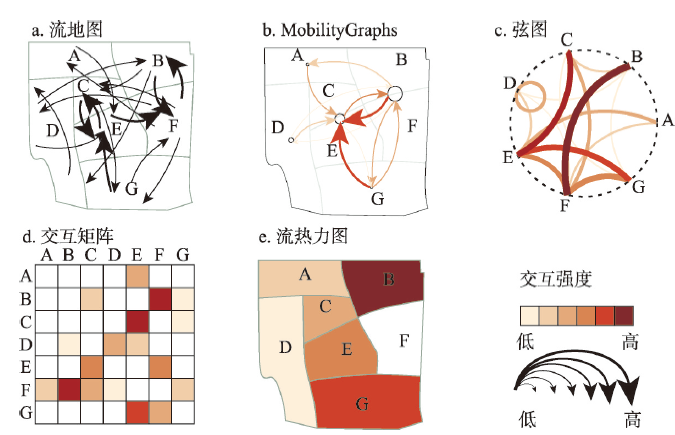

大数据时代的空间交互分析方法和应用再论
|
刘瑜(1971-), 男, 山东人, 教授, 中国地理学会会员(S110007302M), 主要研究方向为地理信息科学。E-mail: liuyu@urban.pku.edu.cn |
收稿日期: 2019-07-23
要求修回日期: 2020-04-14
网络出版日期: 2020-09-25
基金资助
国家自然科学基金项目(41830645)
国家自然科学基金项目(41625003)
版权
Analytical methods and applications of spatial interactions in the era of big data
Received date: 2019-07-23
Request revised date: 2020-04-14
Online published: 2020-09-25
Supported by
National Natural Science Foundation of China(41830645)
National Natural Science Foundation of China(41625003)
Copyright
空间交互是理解地表人文过程的重要基础,与空间依赖一起共同体现了地理空间的独特性、关联性以及对嵌入该空间的地理分布格局的影响,具有鲜明的时空属性,因此对于地理学研究具有重要意义。大数据为空间交互研究带来了新的机遇,能够使我们在不同时空尺度感知和观察空间交互模式并对其动态演化特征进行模拟和预测,从而为揭示人类活动规律及区域空间结构提供有力支持。本文在探讨空间交互与地理空间模式关系的基础上,描述了利用地理大数据感知空间交互的方式和定量模型,介绍了空间交互分析方法的研究进展及其在空间规划与交通、公共卫生、旅游等领域的应用情况,并就一些基本问题进行了讨论,以期为大数据支持下空间交互相关研究提供指导。

刘瑜 , 姚欣 , 龚咏喜 , 康朝贵 , 施迅 , 王法辉 , 王姣娥 , 张毅 , 赵鹏飞 , 朱递 , 朱欣焰 . 大数据时代的空间交互分析方法和应用再论[J]. 地理学报, 2020 , 75(7) : 1523 -1538 . DOI: 10.11821/dlxb202007014
Spatial interaction is a critical basis of understanding human processes on the land surface. Together with spatial dependence, it embodies the uniqueness and relatedness of geographical space, as well as the impact on the embedded geographical distribution patterns. Spatial interaction also has distinctive space-time attributes, and thus it is significant to geographical research. Big data bring new opportunities for the studies of spatial interaction, which enables us to sense and observe spatial interaction patterns at different spatial scales, and simulate and predict their dynamic evolution. This provides great support for the research of human activity regularities and regional spatial structures. In this article, we first demonstrated the relationship between spatial interaction and geospatial patterns, and introduced how to sense spatial interaction with big geodata. Then, we generalized the progress of relevant models and analytical methods, and introduced the corresponding applications in fields of spatial planning, urban transportation, public health and tourism. Some key issues were also discussed. We hope this review can provide guidance for the studies of spatial interaction supported by big data.

Key words: spatial interaction; big data; model; analytical method; application; social sensing
感谢东北大学修春亮教授在本文定稿过程中的讨论和有益的建议。
| [1] |
|
| [2] |
|
| [3] |
|
| [4] |
|
| [5] |
|
| [6] |
|
| [7] |
|
| [8] |
|
| [9] |
|
| [10] |
|
| [11] |
|
| [12] |
|
| [13] |
|
| [14] |
|
| [15] |
|
| [16] |
|
| [17] |
|
| [18] |
|
| [19] |
|
| [20] |
|
| [21] |
|
| [22] |
|
| [23] |
|
| [24] |
|
| [25] |
|
| [26] |
|
| [27] |
[ 龙瀛, 张宇, 崔承印. 利用公交刷卡数据分析北京职住关系和通勤出行. 地理学报, 2012,67(10):1339-1352.]
|
| [28] |
|
| [29] |
|
| [30] |
|
| [31] |
|
| [32] |
|
| [33] |
|
| [34] |
|
| [35] |
|
| [36] |
|
| [37] |
[ 王德, 顾家焕, 晏龙旭. 上海都市区边界划分: 基于手机信令数据的探索. 地理学报, 2018,73(10):1896-1909.]
|
| [38] |
|
| [39] |
|
| [40] |
|
| [41] |
|
| [42] |
|
| [43] |
|
| [44] |
|
| [45] |
|
| [46] |
|
| [47] |
|
| [48] |
|
| [49] |
|
| [50] |
|
| [51] |
|
| [52] |
|
| [53] |
|
| [54] |
|
| [55] |
|
| [56] |
|
| [57] |
|
| [58] |
|
| [59] |
|
| [60] |
|
| [61] |
|
| [62] |
|
| [63] |
|
| [64] |
|
| [65] |
|
| [66] |
|
| [67] |
|
| [68] |
|
| [69] |
|
| [70] |
|
| [71] |
|
| [72] |
|
| [73] |
|
| [74] |
|
| [75] |
|
| [76] |
|
| [77] |
|
| [78] |
|
| [79] |
|
| [80] |
|
| [81] |
|
| [82] |
|
| [83] |
|
| [84] |
|
| [85] |
|
| [86] |
|
| [87] |
|
| [88] |
|
| [89] |
|
| [90] |
|
| [91] |
|
| [92] |
|
| [93] |
|
| [94] |
|
| [95] |
|
| [96] |
|
| [97] |
|
| [98] |
|
| [99] |
|
| [100] |
|
| [101] |
|
| [102] |
|
| [103] |
|
| [104] |
|
| [105] |
|
| [106] |
|
| [107] |
|
| [108] |
[ 王姣娥, 焦敬娟, 金凤君. 高速铁路对中国城市空间相互作用强度的影响. 地理学报, 2014,69(12):1833-1846.]
|
| [109] |
|
| [110] |
|
| [111] |
|
| [112] |
|
| [113] |
|
| [114] |
|
| [115] |
[ 黄洁, 王姣娥, 靳海涛, 等. 北京市地铁客流的时空分布格局及特征: 基于智能交通卡数据. 地理科学进展, 2018,37(3):397-406.]
|
| [116] |
[ 黎智枫, 赵渺希. 赛博空间视角下中国三大城市群网络特征: 基于豆瓣跨城活动数据. 人文地理, 2016,31(6):102-108.]
|
| [117] |
[ 甄峰, 王波, 陈映雪. 基于网络社会空间的中国城市网络特征: 以新浪微博为例. 地理学报, 2012,67(8):1031-1043.]
|
| [118] |
|
| [119] |
[ 魏冶, 修春亮, 刘志敏, 等. 春运人口流动透视的转型期中国城市网络结构. 地理科学, 2016,36(11):1654-1660.]
|
| [120] |
|
| [121] |
|
| [122] |
[ 丁亮, 钮心毅, 宋小冬, 上海中心城就业中心体系测度: 基于手机信令数据的研究. 地理学报, 2016,71(3):484-499.]
|
| [123] |
|
| [124] |
|
| [125] |
[ 焦敬娟, 王姣娥, 金凤君, 等. 高速铁路对城市网络结构的影响研究: 基于铁路客运班列分析. 地理学报, 2016,71(2):265-280.]
|
| [126] |
|
| [127] |
|
| [128] |
|
| [129] |
|
| [130] |
|
| [131] |
|
| [132] |
|
| [133] |
|
| [134] |
|
| [135] |
|
| [136] |
|
| [137] |
|
| [138] |
|
| [139] |
|
| [140] |
|
| [141] |
|
| [142] |
|
| [143] |
|
| [144] |
|
| [145] |
|
| [146] |
|
| [147] |
|
| [148] |
|
| [149] |
|
| [150] |
|
| [151] |
|
| [152] |
|
/
| 〈 |
|
〉 |